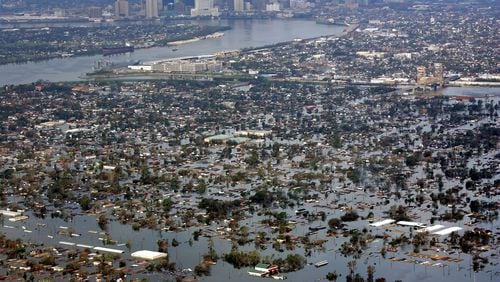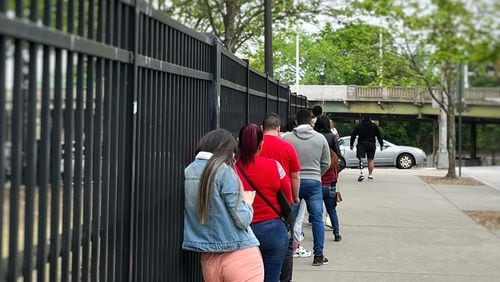Texans are struggling with historic flooding from the lingering Hurricane Harvey, reminding residents of the Gulf Coast of the devastation that Hurricane Katrina brought 12 years ago Tuesday.
From a crowded convention center to scenes of people wading waist-deep in swirling waters, the images seem to eerily mirror what happened on this day in 2005 along the northern coast of the Gulf of Mexico.
Here’s a look at how Katrina came to be and the devastating toll the storm took on New Orleans and the Mississippi Gulf Coast.
Katrina is born
The mass of thunderstorms that would become Hurricane Katrina came together in an area over the Bahamas on Aug. 23, 2005 -- an interaction between a fading tropical depression and a gaining tropical wave. It took the newly formed depression less than 12 hours to strengthen into a tropical storm.
From the beginning, Katrina was a steady, well-organized storm. In the 48 hours after it formed, Katrina would draw strength from the warm waters off the East Coast of Florida and grow into a Category 1 hurricane a couple of hours before making landfall at Hallandale Beach, Florida, some 30 miles north of Miami.
As with most hurricanes, when Katrina made landfall, it lost its source of energy -- the “heat pump effect” -- provided to storms by warm waters and low latitudes.
But the drain in power was only temporary.
The national Hurricane Center downgraded the hurricane to a tropical storm as Katrina cut across Florida’s peninsula. She emerged on the state’s Gulf Coast near Cape Sable on Aug. 26, and forecasters saw falling into place the conditions that would push Katrina on a path up through the Gulf towards a landfall along the northern Gulf Coast.
The next day, as Katrina moved into the Gulf of Mexico, the storm underwent rapid intensification. By the morning of Aug. 28, the National Hurricane Center reported that Katrina was a Category 5 storm with sustained winds of 174 mph. At that time, the storm was predicted to hit near the Florida-Alabama state line.
The Warning
By early morning on the 28th, the storm had not taken the slight turn forecasters had expected. The NHC revised its forecast, moving landfall to the west along the Mississippi Gulf Coast. At 10:11 a.m. local time, Robert Ricks, a National Weather Service meteorologist in Louisiana, issued a statement warning those in the low-lying areas of Louisiana of what was to come:
URGENT — WEATHER MESSAGE
NATIONAL WEATHER SERVICE NEW ORLEANS LA
1011 AM CDT SUN AUG 28, 2005
...DEVASTATING DAMAGE EXPECTED...
HURRICANE KATRINA...A MOST POWERFUL HURRICANE WITH UNPRECEDENTED
STRENGTH... RIVALING THE INTENSITY OF HURRICANE CAMILLE OF 1969.
MOST OF THE AREA WILL BE UNINHABITABLE FOR WEEKS...PERHAPS LONGER. AT
LEAST ONE HALF OF WELL CONSTRUCTED HOMES WILL HAVE ROOF AND WALL
FAILURE. ALL GABLED ROOFS WILL FAIL...LEAVING THOSE HOMES SEVERELY
DAMAGED OR DESTROYED.
THE MAJORITY OF INDUSTRIAL BUILDINGS WILL BECOME NON FUNCTIONAL.
PARTIAL TO COMPLETE WALL AND ROOF FAILURE IS EXPECTED. ALL WOOD
FRAMED LOW RISING APARTMENT BUILDINGS WILL BE DESTROYED. CONCRETE
BLOCK LOW RISE APARTMENTS WILL SUSTAIN MAJOR DAMAGE...INCLUDING SOME
WALL AND ROOF FAILURE.
HIGH RISE OFFICE AND APARTMENT BUILDINGS WILL SWAY DANGEROUSLY...A
FEW TO THE POINT OF TOTAL COLLAPSE. ALL WINDOWS WILL BLOW OUT.
AIRBORNE DEBRIS WILL BE WIDESPREAD...AND MAY INCLUDE HEAVY ITEMS SUCH
AS HOUSEHOLD APPLIANCES AND EVEN LIGHT VEHICLES. SPORT UTILITY VEHICLES
AND LIGHT TRUCKS WILL BE MOVED. THE BLOWN DEBRIS WILL CREATE
ADDITIONAL DESTRUCTION. PERSONS...PETS...AND LIVESTOCK EXPOSED TO THE
WINDS WILL FACE CERTAIN DEATH IF STRUCK.
POWER OUTAGES WILL LAST FOR WEEKS...AS MOST POWER POLES WILL BE DOWN
AND TRANSFORMERS DESTROYED. WATER SHORTAGES WILL MAKE HUMAN SUFFERING
INCREDIBLE BY MODERN STANDARDS.
THE VAST MAJORITY OF NATIVE TREES WILL BE SNAPPED OR UPROOTED. ONLY
THE HEARTIEST WILL REMAIN STANDING...BUT BE TOTALLY DEFOLIATED. FEW
CROPS WILL REMAIN. LIVESTOCK LEFT EXPOSED TO THE WINDS WILL BE
KILLED.
AN INLAND HURRICANE WIND WARNING IS ISSUED WHEN SUSTAINED WINDS NEAR
HURRICANE FORCE...OR FREQUENT GUSTS AT OR ABOVE HURRICANE FORCE...ARE
CERTAIN WITHIN THE NEXT 12 TO 24 HOURS.
ONCE TROPICAL STORM AND HURRICANE FORCE WINDS ONSET...DO NOT VENTURE
OUTSIDE!”
Landfall
Forecasters were not far off on their prediction for landfall. At 6:10 a.m. on Aug. 29, Katrina made its second landfall near Buras-Triumph, Louisiana. Sustained winds were 125 mph. The storm had been downgraded from a Category 4 to a Category 3 only minutes before it crossed the coastline.
The storm made its third U.S. landfall about two hours later along the Mississippi-Louisiana border. It had maintained its winds at around 125 mph and devastated the town of Waveland, Mississippi, knocking out a bridge and pushing two-story homes into each other.
While hurricanes the size of Harvey and Katrina are rare when they hit they do billions of dollars of damage and disrupt lives and services for weeks or months. While the final damage from Harvey is not yet known, Katrina’s damage is something of legend now.
Here is some of what Hurricane Katrina did -- by the numbers.
134,000: The number of housing units (homes and apartments) destroyed in the storm. The number represented 70 percent of New Orleans' occupied housing at the time.
$150 billion: The estimated economic loss caused by the storm.
1,833: The number believed killed by the storm.
80: The percentage of the city of New Orleans that was flooded.
60,000: The number of people rescued by authorities.
90,000: The number of square miles of land damaged by Katrina – that is roughly the size of
1.7 million: The number of electric utility customers left without power following the storm's landfall.
April 17, 2006: The last date when bodies of those believed to have been killed during the storm were found.
30 feet: The highest storm surge from the storm. It hit a 20-mile stretch of the Mississippi coast.
1 million: The number of people along the northern Gulf Coast displaced by the storm.
$120 billion: The amount the federal government spent for recovery of the region.
174 mph: The highest sustained winds the storm produced.
5: At the storm's peak, the category the storm ranked on the Saffir-Simpson Hurricane Scale.
400: The width in miles the storm was at its largest point.
902 millibars: The lowest pressure measured during the storm.
$30 billion: The amount of claims private insurance covered after the storm.
$142 billion: The amount the federal government issued in relief funds for the Southeast following the storm.
53: The number of levee breaches in the federally built levee system built to protect metro New Orleans.
Sources: The Data Center, the National Weather Service, the National Hurricane Center, the Insurance Institute






